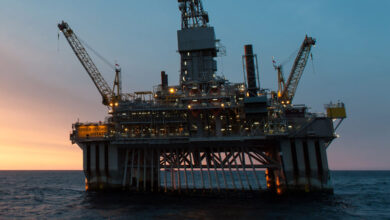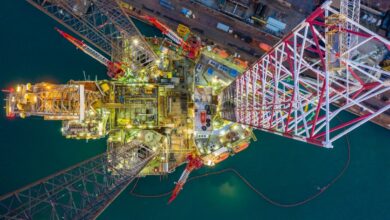Deepwater: Reports of its demise greatly exaggerated, but is service sector bearing the cost?
By Mike Killalea, Editor/Publisher
Reports of the demise of deepwater have been greatly exaggerated, contended executives speaking on a panel on 7 March at CERAWeek by IHS Markit in Houston. Costs have plummeted like lead balloons since the oil price collapse, largely at the expense of the service sector but also through innovations, panelists said.
“I believe that the low-cost investment cycle for deepwater is here,” said Roger Jenkins, President & CEO of Murphy Oil Corp. Mr Jenkins added that deepwater is now competitive with shale and that the deepwater low-cost cycle will last for at least two years.
However, noted Jurgen Brandes, CEO Process Industries & Drives Division, Siemens, “Is this sustainable changes or just pushing (costs) onto the suppliers?”
Mr Jenkins pointed to several trends in the new deepwater economy. First, there is less competition in the deepwater space because numerous E&P companies have exited. Second, long-term contracts for deepwater and ultra-deepwater rigs are expiring, ensuring a large fleet of rigs at fire-sale prices. In fact, he said, rates for ultra-deepwater rigs — the creme de la creme offshore — are at the “bottom of the cycle.”
Other services and facilities, including construction, are likewise much more affordable than three years ago. Similar to deepwater rigs, 20 FPSOs are coming off contract by year-end, Mr Jenkins noted.
To maintain competitiveness, he added, deepwater drilling contractors are decreasing OPEX. Crew complements, for instance, are down 19% compared with 2015. Further, Mr Jenkins said that drilling time and costs have been slashed 36% since 2013.
Mr Jenkins cited figures noting that deepwater can be profitable even at $60 oil, compared with $90, using a Murphy Gulf of Mexico tieback project as an example. Those are no typos —Murphy CEO’s numbers revealed a 27% internal rate of return (IRR) for $60 oil, versus 26% IRR at $90. The primary driver here, according to presented data, was an 18% decline in CAPEX, from $830 million for the $90 case to $680 million at $60.
In another example, Mr Jenkins took on shale, stating that the net present value for an offshore deepwater project was $3.46/bbl, versus $1.57/bbl for a major shale development.
Not that shale is unattractive. Far from it. Murphy is active in that space, as is Statoil, which, according to Carri Lockhart, Senior Vice President US Offshore, Development and Production USA, is also the world’s largest deepwater operator.
“We like onshore,” she said. “We like the flexibility it offers.”
She said that Statoil is nonetheless committed to offshore and plans to drill some 30 exploration wells globally this year. The challenge, Ms Lockhart said, is to ensure that today’s cost savings become sustainable.
“The real achievement,” she said, “will be to sustain improvements when markets recover.”
“Proving the break even is a journey,” she said. Like Murphy, Statoil is finding its cost savings where it can and working to implant them into company culture. In 2013, she said, the Norwegian operator’s break even was $70 oil. Today, it’s less than $30.
She noted that Statoil has adopted a firm stance on controlling service costs and insisting on a non-negotiable $50 break-even. “Statoil has added great value by saying ‘no,’ ” Ms Lockhart said.
In this industry, wild pendulum swings are the natural order of things. It’s a deja-vu cycle of cycles repeated consistently, as if torn from the movie “Groundhog Day.”
The trick is to stop the pendant in the center and hold it in place. So far, no one has figured out how.




